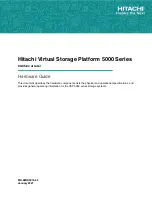
to data is preserved if one disk in each mirrored pair remains available. In some
cases, RAID 10 offers faster data reads and writes than RAID 5 because it is not
required to manage parity. However, with half of the disk drives in the group used
for data and the other half used to mirror that data, RAID 10 arrays have less
capacity than RAID 5 arrays.
Note:
RAID 6 is the recommended and default RAID type for all drives over 1 TB.
RAID 6 and RAID 10 are the only supported RAID types for 3.8 TB Flash Tier 1
drives. RAID 6 is the only supported RAID type for 7.6 TB Flash Tier 2 drives.
Logical subsystems
To facilitate configuration of a storage system, volumes are partitioned into groups
of volumes. Each group is referred to as a logical subsystem (LSS).
As part of the storage configuration process, you can configure the maximum
number of LSSs that you plan to use. The storage system can contain up to 255
LSSs and each LSS can be connected to 16 other LSSs using a logical path. An LSS
is a group of up to 256 volumes that have the same storage type, either count key
data (CKD) for IBM Z hosts or fixed block (FB) for open systems hosts.
An LSS is uniquely identified within the storage system by an identifier that
consists of two hex characters (0-9 or uppercase AF) for which the volumes are
associated. A fully qualified LSS is designated using the storage system identifier
and the LSS identifier, such as IBM.2107-921-12FA123/1E. The LSS identifiers are
important for Copy Services operations. For example, for FlashCopy operations,
you specify the LSS identifier when choosing source and target volumes because
the volumes can span LSSs in a storage system.
The storage system has a 64K volume address space that is partitioned into 255
LSSs, where each LSS contains 256 logical volume numbers. The 255 LSS units are
assigned to one of 16 address groups, where each address group contains 16 LSSs,
or 4K volume addresses.
Storage system functions, including some that are associated with FB volumes,
might have dependencies on LSS partitions. For example:
v
The LSS partitions and their associated volume numbers must identify volumes
that are specified for storage system Copy Services operations.
v
To establish Remote Mirror and Copy pairs, a logical path must be established
between the associated LSS pair.
v
FlashCopy pairs must reside within the same storage system.
If you increase storage system capacity, you can increase the number of LSSs that
you have defined. This modification to increase the maximum is a nonconcurrent
action. If you might need capacity increases in the future, leave the number of
LSSs set to the maximum of 255.
Note:
If you reduce the CKD LSS limit to zero for IBM Z hosts, the storage system
does not process Remote Mirror and Copy functions. The FB LSS limit must be no
lower then eight to support Remote Mirror and Copy functions for open-systems
hosts.
Allocation methods
Allocation methods (also referred to as extent allocation methods) determine the
means by which volume capacity is allocated within a pool.
Chapter 1. Overview
17
Summary of Contents for DS8882F
Page 34: ...24 DS8882F Introduction and Planning Guide...
Page 46: ...36 DS8882F Introduction and Planning Guide...
Page 70: ...60 DS8882F Introduction and Planning Guide...
Page 86: ...76 DS8882F Introduction and Planning Guide...
Page 98: ...88 DS8882F Introduction and Planning Guide...
Page 120: ...110 DS8882F Introduction and Planning Guide...
Page 126: ...116 DS8882F Introduction and Planning Guide...
Page 132: ...122 DS8882F Introduction and Planning Guide...
Page 134: ...124 DS8882F Introduction and Planning Guide...
Page 138: ...128 DS8882F Introduction and Planning Guide...
Page 140: ...130 DS8882F Introduction and Planning Guide...
Page 158: ...148 DS8882F Introduction and Planning Guide...
Page 163: ......
Page 164: ...IBM Printed in USA GC27 9259 00...
















































